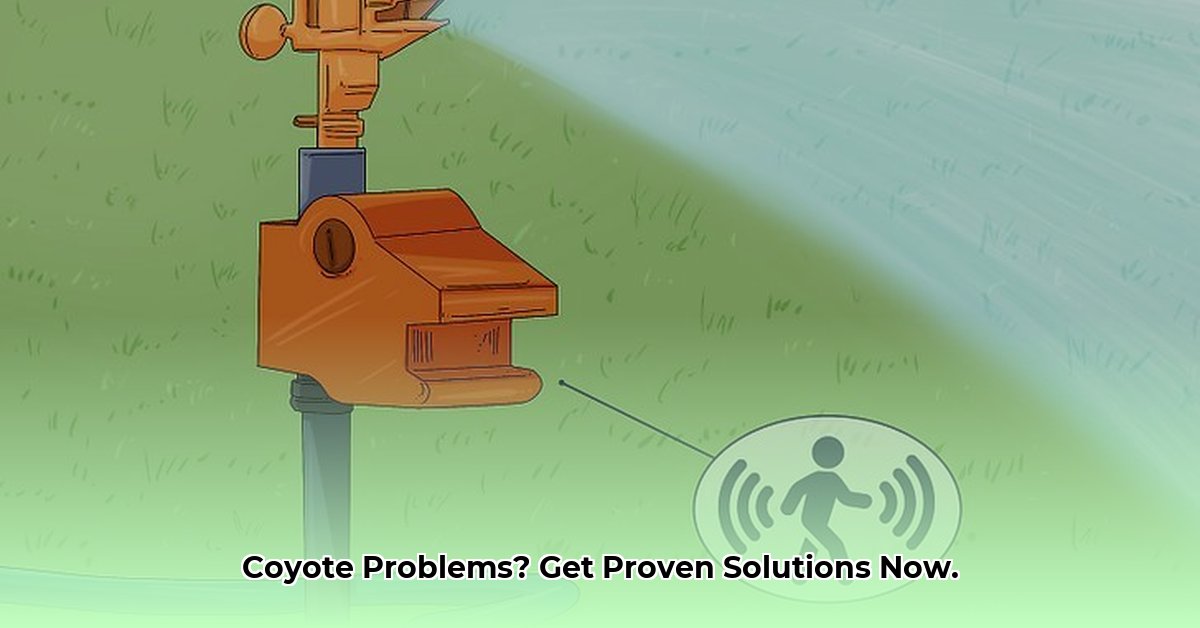Understanding Your Coyote Neighbors
Coyotes are intelligent and adaptable animals, driven by the same basic needs as any other creature: food, water, and shelter. They’re most active at dawn and dusk, and their opportunistic nature means they’ll take advantage of any readily available food source. Understanding their behavior is the first step towards effective deterrence. During pupping season (typically spring into early summer), coyotes may be more protective, so extra vigilance is recommended.
Making Your Property Less Appealing to Coyotes
Deterring coyotes is primarily about making your property less attractive and establishing boundaries. This isn’t about eliminating coyotes—they’re a natural part of the ecosystem—but rather encouraging them to seek resources elsewhere.
Secure Food Sources
- Garbage: Use tightly sealed garbage cans, ideally with bungee cords or weights to prevent access. Consider metal or heavy-duty plastic containers.
- Pet Food: Feed pets indoors and promptly remove any leftover food and water bowls.
- Compost: Use enclosed compost bins, not open piles. Turn the compost regularly to minimize odors.
- Fallen Fruit: Regularly collect and dispose of fallen fruit from trees and bushes.
- Bird Feeders: If you choose to keep bird feeders, use trays to minimize spilled seed and clean up regularly. Consider removing feeders altogether if coyote activity is high.
- Grills: Clean grills thoroughly after each use to remove food residue and grease.
Eliminate Water Sources
Address any drainage issues that create puddles or standing water. Ensure dripping faucets and clogged gutters are repaired. If you have a pool or pond, consider covering it when not in use.
Modify Landscaping
Trim back overgrown bushes and tall grasses, especially those close to your house. These can provide hiding places for coyotes and their prey. Remove woodpiles and other debris that could offer shelter.
Building Barriers
Fencing
A well-constructed fence can be a significant deterrent. A fence should ideally be 6-8 feet tall and extend 12-18 inches underground with an L-footer to prevent digging. Coyote rollers—rotating cylinders at the top of the fence—can further deter climbing. Chain link, welded wire mesh, or wood are suitable fencing materials.
Humane Hazing Techniques
Hazing is a method of teaching coyotes to fear humans without causing harm. The goal is to make encounters with your property unpleasant, encouraging them to stay away.
Hazing Methods
- Noise: Yell loudly, use an air horn, bang pots and pans, or use a whistle.
- Water: Spray coyotes with a garden hose.
- Projectiles: Toss small rocks or sticks near the coyote (not directly at it) to startle it.
- Motion-Activated Deterrents: Install motion-activated sprinklers, lights, or noisemakers.
Hazing Best Practices
- Be Consistent: Haze coyotes every time you see them on your property.
- Be Big and Loud: Make yourself appear large and intimidating.
- Don’t Run: Running can trigger a coyote’s prey drive. Stand your ground and maintain eye contact.
- Multiple Methods: Combine different hazing techniques for greater effectiveness.
Protecting Pets and Children
- Supervision: Never leave small children or pets unattended outdoors, especially at dawn and dusk.
- Leashes: Keep pets on a short leash, even in your own yard. Discourage pets from chasing coyotes.
- Secure Enclosures: If pets are kept in outdoor enclosures, ensure they are fully enclosed and secure with a roof.
Coyote Deterrents at a Glance
| Deterrent Strategy | Description | Effectiveness | Notes |
|---|---|---|---|
| Secure Attractants | Eliminate food and water sources, secure garbage, and clean up fallen fruit. | Very High | Reduces the incentive for coyotes to visit. |
| Fencing | Install a tall (6-8ft) fence extending below ground (12-18 inches) with an L-footer and coyote rollers (if possible). | Very High | Creates a physical barrier to prevent entry. |
| Hazing | Scare coyotes with loud noises, water hoses, or thrown objects near them. Be consistent. | High | Conditions coyotes to avoid your property. Requires consistent and assertive action. |
| Motion-Activated Deterrents | Employ motion-sensing sprinklers, lights, and/or noisemakers to surprise and deter coyotes. | Moderate | Coyotes may habituate to these deterrents over time. |
| Repellents | Utilize commercial repellents or DIY solutions like ammonia-soaked rags (with caution). | Low to Moderate | Effectiveness can vary, and reapplication is frequently necessary. |
Ongoing Coyote Management and Coexistence
Effective coyote deterrence is a continuous process. Regularly inspect and maintain fences, be vigilant during pupping season, and adapt your methods as needed. Consult your local wildlife agency for specific recommendations and resources. While complete eradication is not feasible or desirable, implementing these strategies can help you coexist peacefully with coyotes while safeguarding your property, family, and pets.
It’s important to acknowledge that research on coyote behavior and effective management strategies is ongoing. What works in one situation or area may not work in another. Your local wildlife agency is the best resource for tailored advice based on current research and local conditions. Some evidence suggests that coyotes can adapt to and even learn to ignore certain deterrents over time. Therefore, a multifaceted approach that combines various deterrents and preventative measures may be the most effective long-term solution. By understanding the complexities of coyote behavior and adapting our strategies, we can strive to coexist peacefully with these adaptable animals.
- How to Get a Free Mold Inspection (and Avoid the Scams) - April 23, 2025
- How to Flush a Toilet Without Water: A Step-by-Step Guide - April 23, 2025
- The Complete Guide to Safely Disposing of Light Globes - April 23, 2025










